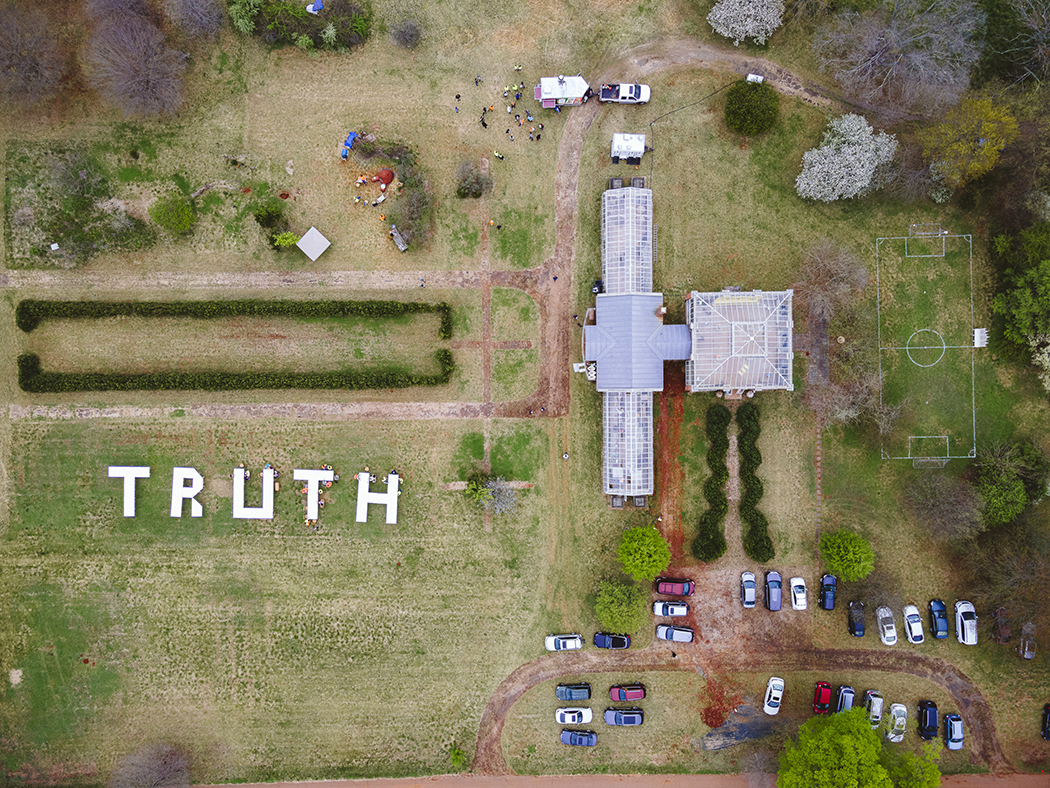The folks behind the art installation known as the Truth Farm want everyone to know the truth about immigration.
But what is the truth? And could there be more than one?
Unveiled on Refugee Investment Network founder and managing director John Kluge’s family property within the Trump Winery, the Truth Farm installation first centered around a 120-foot sign spelling out “TRUTH” in mylar. Aid workers often give mylar blankets to refugees seeking asylum, and artist Ana Teresa Fernandez used the material to draw attention to wider immigration issues—namely, that worldwide systemic problems beyond people’s control drive them to flee their countries for safety.
The artist’s Truth Table is surrounded by chairs, places where those with different opinions might come to sit, literally break bread, engage, and talk through complex immigration issues.
“When people become entrenched in their ideas, they pull a sound bite or barrage of sound bites that they have been spoonfed, and that becomes their understanding of an issue,” Kluge says. “When people harden their views, they lose their curiosity. You have to be curious to understand issues. Truth requires some inquiry and listening to others.”
Kluge is not an artist, he says, or even a professional curator. But he thought art might kindle at least some people’s curiosity. A U.S.-Mexico Foundation board member, Kluge conceived the Truth Farm project along with the group’s deputy director, Enrique Perret, and Fernandez. Fernandez had previously worked with mylar and thought it fit the Farm perfectly.
The installation grew from there. In addition to the Truth Table, the Truth Farm artwork includes a working adobe oven built by artist Ron Rael and portraits by undocumented dreamer Arleene Correa Valencia. Valencia’s pieces depict migrant parents and their children against black backgrounds. A friend of Fernandez’s and a professional artist herself, Valencia composes the parents using reflective material and fabric repurposed from her own family’s clothing. She etches the children in glow-in-the-dark thread, implying them only by an empty background.
“When you mix the two, you are seeing a full, embodied parent holding the idea of a child,” Valencia says. “The portraits start to create a conversation about separation and the layers that occur through immigration.”
The Truth Farm artwork itself has now begun a migration. Some of Valencia’s work is currently featured at the Instituto Cultural de México in Miami and will next travel to Wisconsin. Federico Cuatlacuatl’s Truth Farm contribution, sculptures in the shape of traditional Mexican kites, has moved to a museum in Toledo. The Truth Farm organizers hope to take Rael’s ovens on the road to host dinners over the next several months, while the Truth Table itself has traveled to Champion Brewing Company and the IX Art Park.
Kluge, Valencia, and Fernandez hope the art’s impact extends even further. They are planning another physical installation in Napa Valley, California. While they positioned the first piece next to a Trump property to draw the former president’s attention, the work of pushing folks to talk through immigration issues continues, even as a new commander-in-chief has taken office.
“I think that one of the really interesting things that has been occurring is the shift in all the information coming out after what happened on January 6 at the Capitol,” Fernandez says, referring to this year’s armed insurrection at the U.S. Capitol in Washington, D.C. “There has been a lot of reconciliation with the facts, but all of this rhetoric is still permeating. It is still a tug of war with this word [truth], and with John being Trump’s neighbor, we enacted everything we want to see good neighbors doing—cooking together and bringing people to the table, being inclusive not exclusive.”
